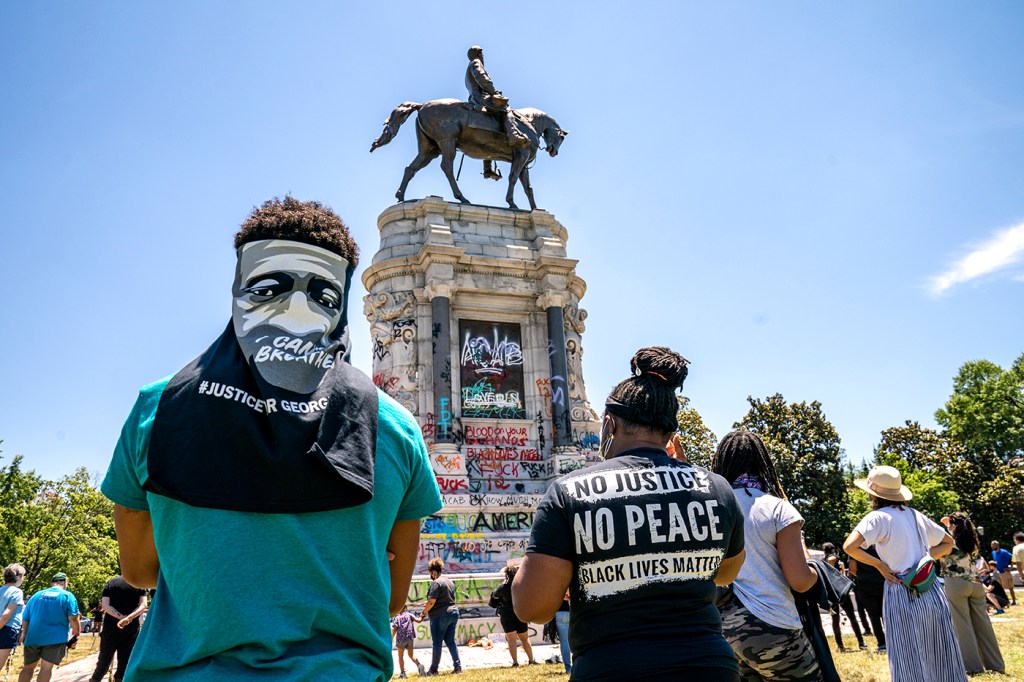Why is there a renewed push to bring down Confederate monuments after George Floyd’s death?

The subject of a long-standing national debate, public symbols of the Confederacy—staunchly defended by some and widely reviled by others—are garnering renewed attention amid the nationwide protests against police violence and racial injustice in the U.S.
There’s speculation that the swiftness of the response from protesters and city leaders to remove symbols of white supremacy signals a readiness from some to go beyond merely talking about it. On Wednesday, NASCAR announced that it is banning Confederate flags from its race tracks and events. And in a matter of just weeks after George Floyd’s killing by a Minneapolis police officer, contentious statues have been toppled and defaced across the South.
Patricia Davis, an associate professor of communication studies at Northeastern, says that while she is excited about the reinvigorated campaign to remove the memorials, she is also conscious of the reality that previous grassroots attempts haven’t always produced the results desired by detractors.

Patricia Davis is an associate professor of Communication Studies in the College of Arts, Media and Design at Northeastern. Photo by Ruby Wallau/Northeastern University
“In the past, these smaller acts of resistance were usually met with the replacement of the monuments, and often in bigger, more imposing versions of them,” she says.,“[whereas] when state authorities remove them, they tend to be permanent removals, and make a stronger statement about the community’s values.”
But, she adds, “There is also a strong possibility that, this time, they won’t be replaced with bigger, more offensive Confederate monuments.”
Davis says that to Black people, the monuments are a reminder of the painful history of slavery and the Jim Crow era, whereas some white Americans, she argues, claim to view them as historical markers or an emblem of a heritage, which includes the preservation of white supremacy.
“But whiteness doesn’t have quite the currency that it had 50 years ago. So these statues serve as reminders of what that currency was—and also to African Americans that they’ll never be fully considered citizens,” Davis says.
Davis has studied how Black people chronicled their lives before, during, and immediately after the Civil War, and specifically, she has analyzed how Black history museums have memorialized the experience of people of African descent from the late 18th century to the late 19th century. As part of that work, she has also examined efforts to remove Confederate monuments.
In an essay, titled “In the Aftermath: Memorials of the Confederacy, Symbols of Oppression, and the Rhetoric of Removal,” for the book Rhetoric, Race, Religion, and the Charleston Shootings, Davis argues that the removal of Confederate monuments is an example of a “speech act”—an act that can be performed by saying that one is doing so—designed to produce a discourse of resistance.
“One of the arguments I make in the essay is that the removal of the Confederate monuments—by the state—has much greater rhetorical force than individual acts of resistance, such as defacing them or individuals or groups destroying them,” she says.
The discourse around Confederate symbols has traditionally revolved around the perspectives of white people, says Davis, but the Black Lives Matter protests seek to change that.
“There have been many discourses to suggest to Black people that their lives have no value, and Confederate monuments are one of the more influential ways in which this particular sentiment has been expressed,” Davis says. “It takes a couple of degrees to get there, but removal does serve as a statement that your lives have value because your historical experiences have value.”
While it’s too early to tell whether the current protests will lead to lasting change, Davis says she is “cautiously optimistic that this time, things may be different” on turning the tide on racism and inequality. She says she is encouraged by the public sentiment from local governments and businesses and the solidarity shown by people around the world.
“I will wait to see exactly how this plays out, because even though this one does feel different, we have had situations in the past where it looked like things were going to change and they did not—in fact, they got worse in some cases,” she says. “So we’ll see.”
For media inquiries, please contact media@northeastern.edu.





